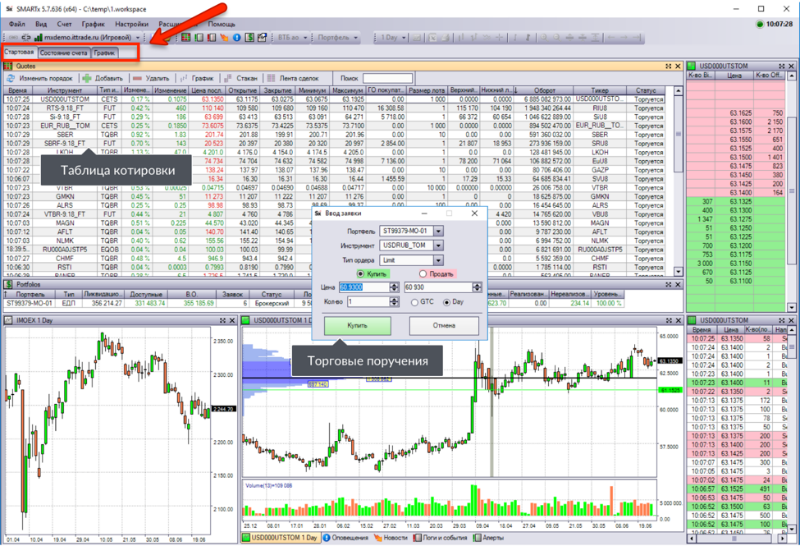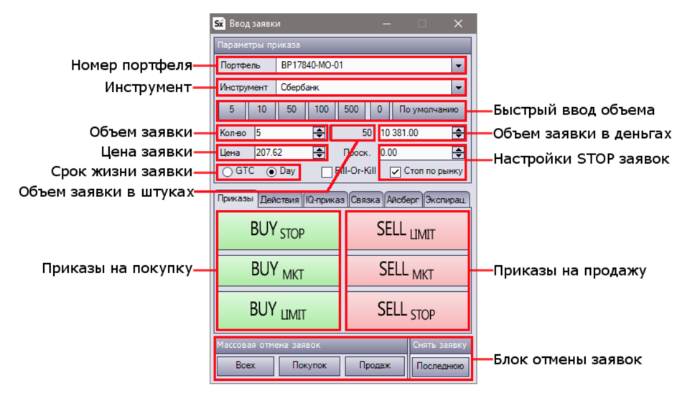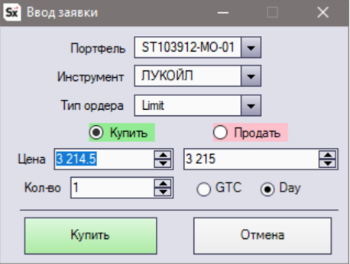How are changing approaches to the development of terminals for trading on the stock exchange: 4 trends in 2018

We at ITI Capital have been developing our own tools for trading on Russian and foreign exchanges for over 10 years. During this time, the requirements for such products and approaches to their development have changed repeatedly. Today we will talk about the main trends of the current year, using as an illustration the recent changes with our SMARTx terminal .
Convenience Request
Competition in the field of trading terminals is currently extremely tough - the main products of different companies have been developing for many years, so they have become “overgrown” with serious functionality that is difficult to expand significantly. New features introduced in one program are quickly implemented by developers of other systems.
As a result, users pay more attention to the overall convenience and speed of the product, as well as the quality of the interface. If several years ago the main thing was to implement as many new functions for trading on the stock exchange as possible, now there is a request for convenience and beautiful interfaces. At the same time, even from specialized software such as a trading terminal, users are waiting for interaction mechanics that are familiar to work with “general purpose” programs like browsers.
Therefore, in our terminalSMARTx, we have implemented the ability to add additional desktops with different layouts of windows and tables in the form of tabs “as in a browser” - this is the first step towards a large-scale redesign of the interface.

Browser-like workspace tabs
The complex becomes simple
In one of the previous materials, we looked at trends in the interface of mobile trading terminals . One of the most notable projects in this area is the startup Robinhood, which allows you to make transactions on the stock exchanges using tapes and swipes in an extremely simple and convenient application. Recently, a request for such a simplification is noticeable in the segment of desktop trading software.
In the initial version of the terminal, we provided a window for entering a purchase or sale order, in which it was possible to set a variety of parameters for a future transaction:

Advanced window for entering an order
However, over time, it turned out that for many users, so much information at the bidding stage is not needed, and all needs are reduced, in fact, to the “buy” and “sell” buttons. I had to make a simplified version of this window:

Simplified window for entering a request
In addition, when trading via the SMARTx terminal, it is possible to protect an already open position with stop orders (they allow, for example, to automatically sell stocks when a certain price is reached - this allows you to take profits or limit loss on the transaction).
Previously, this function was also implemented quite difficult - the settings for such transactions were set in one of the deep menu of the program. The idea was that it simplifies further bidding, but it turned out that in practice it is easier for users to drive in all the parameters, since they often change. As a result, this function has also been adjusted and simplified.
The more data the better
Not the most obvious point, but the desire of users for simplicity and convenience does not mean a reduction in the flow of data displayed in the program. On the contrary, more flexible options for customizing the workspace stimulate the user's desire to load as many different trade information as possible on each tab.
For example, in previous versions of our terminal it was possible to create only one window of quotations - this is one of the heaviest windows, because it presents a huge amount of data on various stocks, futures and other instruments. For each of them, the program pumps several tens of megabytes of data, and there may be a lot of open tools.

Terminal quotation table
However, the request for the introduction of the possibility of opening a set of tables of quotations was one of the most popular, so over time it was implemented. Users were able to create multiple quote windows (as well as windows with data on the state of the portfolio, orders, transactions and open positions). A special plugin was also developed .
Performance is very important
The point arising from the previous one is that the requirements for the performance of trading terminals are increasing year by year. We have already talked about how the new SMARTx productivity enhancement mechanisms were lacking. Among the previously implemented "features" were:
- Delayed rendering of tables and graphs - they are updated when new data arrives and after the main thread is freed from processing the message queue.
- Filtering of loaded data streams - with increasing market activity, the terminal learned to “discard” outdated data and show only the most relevant information.
- Reduced memory traffic - we created our own memory management for frequently changing and updated objects and collections. As a result, it was possible to reduce the number of garbage collections during the terminal operation, as a result, the terminal does not freeze and can work without rebooting for an unlimited time without increasing the amount of memory consumed.

Performance test when opening a large number of graphs in the terminal
However, despite all these innovations, problems remained. For example, initially only a 32-bit version of the terminal was created - and even in 64-bit operating systems it worked. However, over time, it turned out that this situation is not suitable for all customers.
Among our users there are many who use trading robots and automated means of trading, and the terminal for them serves as a tool for monitoring the situation on the market. For such traders, the number of orders and transactions can amount to thousands or even tens of thousands per day, while there is a trend towards an increase in trading volumes. At the same time, in 32-bit systems there is a restriction on the memory consumed by the application, therefore, with a large number of transactions and orders, at a certain moment the terminal just started working extremely slowly and “fell”. To solve this problem, we had to rework the platform and create a 64-bit version of SMARTx.
Conclusion
Trading on the stock exchange is a fairly conservative niche, despite its manufacturability. There are examples of cult products that, despite the fact that the interface is not the most modern, remain extremely popular due to the unique set of data provided (for example, the Bloomberg terminal ).
However, over time, users have a desire to work with tools that are closer to those programs and services that they use all the time - like the same browsers. So, the developers of the trading terminals will have to continue to think about how to make the program easy, beautiful and fast, and at the same time accommodate as much useful information as possible.
Other materials on finance and stock market from ITI Capital :
- Analytics and market reviews
- Exchange software: the history of the creation of the trading terminal
- The evolution of trading terminals: Mobile trading in the era of touch interfaces
- Need for speed: Optimization of the trading terminal performance
- The power of habit: Why a bad interface and high cost do not affect the popularity of the terminal Bloomberg
